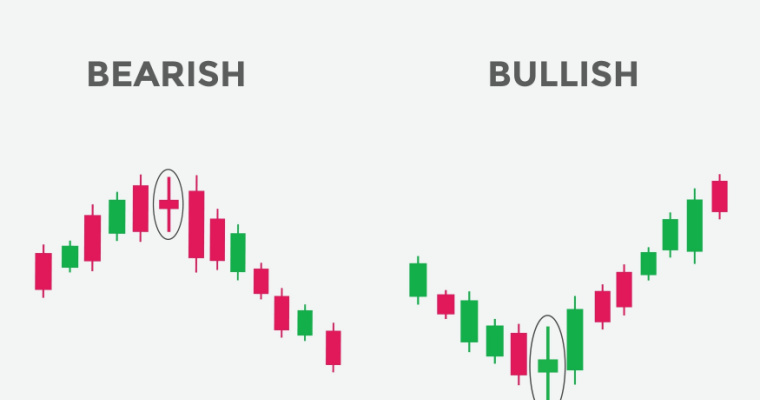Spinning Top Candlestick: Meaning, Example, Limitations

A spinning top candle helps traders in gauging the depth of uncertainty prevailing in a stock or overall market with respect to the buyers and sellers. It exhibits a situation where neither the buyer nor seller has the upper hand after a trading session. In other words, if you are a trader, you must learn about spinning top candlestick.
This article is a trader’s guide to spinning top candlestick. Read on to get all the details.
What is a Spinning Top Candlestick?
This is a candlestick pattern comprising a short body between long upper and lower wicks. Under this pattern, the closing price of a security gets very close or becomes similar to its opening price.
It indicates the probability of trend reversal in stock after a fall in the price level. The market has a general indecisiveness, with several sideways movements lined up. Hence, it is a neutral pattern.
The close of this candle may exhibit a bearish or bullish trend. A bullish trend will increase the price of a security or stock to bring it closer to its opening values. On the other hand, a bearish trend means a decline in the price of a stock closer to its opening value.
How is Spinning Top Candlestick Formed?
This pattern allows traders to work within their stipulated time period. Buyers and sellers associated with this process manoeuvre security prices higher or lower during the trading session. As the trading session nears completion, the closing price starts to trudge towards the opening price.
In this scenario, a trader who has a bullish outlook forces prices back to the top level before closing. A lower wick and long upper indicate market turbulence or volatility during trading, with neither bears nor bulls gaining the upper hand.
Basically, we can conclude that a spinning top candlestick pattern symbolises exhaustion after a period of upsides and downsides in the market.
How to Identify Spinning Top Candlestick?
This pattern is symmetrical, having equal lengths of upper as well as lower shadows. However, the main body of the spinning top candlestick is small in length, which means only a marginal difference between the opening and closing prices of a security.
This appearance occurs due to pulls and pressures faced by stock from both sellers and buyers. Due to these factors, we get to see a relatively short candlestick with elongated shadows on both sides.
Market buyers try to push up prices, and at the same time, market sellers try to push these prices on a downtrend. However, both fail to sustain their momentum, which leads to a situation of status quo.
As per analysts, the spinning candlestick means that the current trend may be fizzing out and chances of trend reversal increasing.
What Are the Components of Spinning Candlestick and What Do They Indicate?
Here are three components of the spinning candlestick pattern and their implication:
1. Upper Shadow
It is responsible for connecting the day’s high with the real body. In case it shows a green candle, it means that day’s high and closing price are interrelated. On the other hand, if this shows a red candle, it indicates a connection between the day’s high and the opening price.
2. Small Real Body
This indicates the closeness between the opening and closing price of a security. For example, suppose the opening price of a stock was Rs. 125, and its closing price was Rs. 120. This indicates closeness between them.
As the opening and closing prices are quite close to each other, there is a formation of a small body. However, the colour of this body becomes insignificant.
3. Lower Shadow
It indicates a connection between a day’s low and the real body of this candlestick pattern. If it shows a green candle, it means that day’s low and opening prices have a connection. Whereas if there is a red candle, it will exhibit a relationship between the day’s low and the closing price.
Also Read
How to Trade the Spinning Top Candle?
Unlike other candlestick patterns that provide clear trading signals, this pattern does not give clear signs to traders. There are no explicit entry and exit signals that traders can use to recalibrate their position in the market.
If you are a live trader, it is advisable not to immediately enter the market after looking at the spinning top candlestick. Consider waiting for confirmatory signals for the trend by looking at other technical tools.
You can look at contracts for difference while trading in securities that show a spinning top candlestick pattern. Under this, there is no ownership requirement for the underlying asset. However, you may speculate on its price patterns. After getting confirmation on the ongoing trend, you can move ahead with trading in a particular direction.
How to Handle Risk with Spinning Top Pattern?
A bearish spinning top will mean that there are chances of a bearish reversal in the market. On the other hand, a bullish spinning top indicates a bullish reversal in markets.
When you are using these tools for technical analysis of a stock, it is important to have a particular risk management plan. Moreover, as this pattern indicates overall indecisiveness in markets, conservative traders can choose to stay away as there is no definite trend.
Meanwhile, aggressive traders can make a move and bet on trend reversal by analysing whether it is a bearish or bullish spinning top.
Example of a Spinning Top Candlestick
Let’s consider an example of this candlestick pattern, which will provide us clarity about this concept. Let’s say the stock of Company ABC opened at Rs.256.
However, as sellers start to enter the market, the stock price hits a new low, dropping down to Rs.235. Looking at the fall in stock prices, buyers step in and purchase Company ABC’s stocks in large numbers. This increases its price to a day’s high of Rs.274.
The pull from both sides continues, and stock settles and closes at Rs.260. This will lead to the formation of a bullish spinning top candlestick pattern.
Differences Between Doji and Spinning Top Patterns
Both these patterns represent some form of indecisiveness; however, there are certain differences between these patterns, which are as follows:
| Parameter | Doji | Spinning top |
| Body Structure | They are relatively smaller in size. It contains a small body and smaller lower and upper shadows. | Spinning tops have longer lower and upper shadows in their patterns. |
| Profits | You can easily assess the level of profit as there are definite price targets. | Not easy to assess reward or profit potential. This is because there are no definite price targets. |
What Are the Limitations of Spinning Top Patterns?
Here are some limitations of spinning top candlestick patterns:
- These are quite common patterns as they always form when the price of a security is witnessing a sideways movement. Hence, it becomes difficult to assess whether these patterns do indicate certain trend reversals.
- While forecasting future action plans, you need confirmation from other technical tools, as this is quite a common pattern and may not mean something consequential.
- The risk-reward potential of placing stop loss targets just above or below the high or low of a spinning top is quite low. It means you may be dealing with a higher risk in comparison to the expected reward.
Final Word
Spinning top candlestick is an important tool that exhibits a neutral trend in a particular stock or security. As the closing price is nearer to the opening value, it means that neither the bulls nor the bears are dominating the current phase of trading. However, it becomes imperative for investors to consider other trading tools and charts to get confirmatory signals before starting their trades.
You can also diversify your portfolio with various Navi mutual funds. Download the Navi App and start SIP at just Rs.10 now!
FAQs
Ans: A downtrend means a fall in the price of respective stocks or security. A spinning top in an ongoing downtrend may mean that bears are consolidating their positions with another round of selling due. It may also mean a reversal of a trend.
Ans: An uptrend means a rise in the price of the stock. A spinning top in an uptrend may mean control of bulls in that particular stock, and respective stocks may see heavy buying in future trading sessions.
Ans: A bearish spinning top will come with a red candle. On the other hand, the bullish spinning top pattern will be dominated by green candles.
Ans: Whenever these patterns at the support level are white or black, the spinning top represents a bullish sentiment. On the other hand, whenever these candlesticks at resistance levels are black or white, this pattern represents bearish tendencies or sentiments.
Want to put your savings into action and kick-start your investment journey 💸 But don’t have time to do research? Invest now with Navi Nifty 50 Index Fund, sit back, and earn from the top 50 companies. Disclaimer: Mutual Fund investments are subject to market risks, read all scheme-related documents carefully. This article has been prepared on the basis of internal data, publicly available information and other sources believed to be reliable. The information contained in this article is for general purposes only and not a complete disclosure of every material fact. It should not be construed as investment advice to any party. The article does not warrant the completeness or accuracy of the information and disclaims all liabilities, losses and damages arising out of the use of this information. Readers shall be fully liable/responsible for any decision taken on the basis of this article.

Customer’s Feedback
No comments found.10 Best Demat Accounts in India for Beginners in 2023
Creation of Demat accounts revolutionised the way trades were conducted at the stock exchanges. It... Read More »10 Best SIP Plans for 1000 Per Month in India 2023
Systematic Investment Plan (SIP) is an investment style or route with which you can invest a fixed ... Read More »How to Invest in Mutual Funds in India – Easy Steps
Mutual funds can be an excellent way to diversify your portfolio and gain exposure to a wide range ... Read More »20 Best Nifty 50 Index Funds in India to Invest in April 2023
What is the Nifty 50 Index Fund? Nifty 50 index funds are a type of passively-managed equi... Read More »Asset Management Company (AMC) – Types and Benefits
What is an Asset Management Company (AMC)? Asset Management Company or AMC is a financial ... Read More »10 Best Gold Mutual Funds to Invest in India (April 2023)
Gold Mutual Funds are funds that invest in gold and gold-related assets such as bullion, coin... Read More »20 Best Flexi Cap Mutual Funds to Invest in India 2023
Flexi-cap funds are mutual fund schemes that aim to invest in stocks of companies across market cap... Read More »Best SIP Plans for 15 years – Top 10 SIP Plans to Invest in India 2023
A systematic investment plan (SIP) could be a convenient mode or style of investing in mutual funds... Read More »10 Best SIP Plans for 1 year Investment in India 2023
There has been a massive surge in SIP or Systematic Investment Plan investors in recent years. As p... Read More »10 Best SIP Plan for 3 Years in India to Invest in 2023
SIP or Systematic Investment Plan helps bring investment discipline in an investor’s life. It’s... Read More »10 Best SIP Plan for 10 years India in 2023 – Returns and Performance
Ask any beginner mutual fund investor and most of them would tell you that their preferred mode of ... Read More »10 Best SIP Plans for 5 years in India to Invest in 2023
Systematic Investment Plan (SIP) could be an effective investment mode if you want to invest a fixe... Read More »Top 10 Chit Fund Schemes in India in 2023
Chit funds are one of the most popular return-generating saving schemes in India. It is a financial... Read More »10 Best Gold ETFs in India to Invest in April 2023
Gold ETFs or Gold Exchange Traded Funds are passively managed funds that track the price of physica... Read More »10 Best Demat Accounts in India for Beginners in 2023
Creation of Demat accounts revolutionised the way trades were conducted at the stock exchanges. It... Read More »20 Best Index Funds to Invest in India in April 2023
What is an Index Fund? An index fund is a type of mutual fund or exchange-traded fund (ETF) that... Read More »Best Arbitrage Mutual Funds to Invest in India in April 2023
Arbitrage funds are hybrid mutual fund schemes that aim to make low-risk profits by buying and sell... Read More »10 Best SIP Plans in India to Invest in April 2023
What is SIP? SIP or Systematic Investment Plan is a method of investing a fixed amount in ... Read More »10 Best Corporate Bond Funds in India to Invest in April 2023
Corporate bond funds are debt funds that invest at least 80% of the investment corpus in companies ... Read More »10 Best Bank for Savings Account in India [Highest Interest Rate 2023]
Savings account is a type of financial instrument offered by several banks. It lets you safely depo... Read More »































